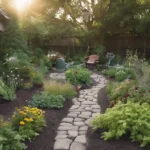Shrub and Tree Clearing | Best Practices for Lasting Results
Overgrown shrubs, small trees growing even though you never planted them, rotting vegetation, all these things can make your yard feel wild and unkept for all the wrong reasons. However, with smart shrub and tree clearing, you can protect your soil and make your yard look neat simultaneously. In this guide, we will break down professional methods used at Eye Candy Lawncare CO for durable results, and garden maintenance tips you can keep up with.
Step 1: Proper Site Assessment
Before yanking or cutting, assess your yard and take a few minutes to map out a plan. Here’s how:
- Identify Species: This can range from woody shrubs to clumping
- Size & Density: Can a single shrub be removed?
- Nearby Assets: Assess nearby surroundings like lawn, irrigation lines, hardscape, property lines, overhead branches, and utilities.
- Slope & Drainage: Clearing on a slope requires erosion control.
- Habitat Check: Look for bird nests or bee hives to avoid habitat damage; time work to avoid nesting periods when possible.
Pro Tip: Photograph the area before you start, then again after each phase to spot missed stumps and track your progress for follow-ups.
Step 2: Timing Matters
Although shrub removal or small tree removal can be done anytime, the best windows are:
- Dormant Seasons (Late fall to early spring): This means fewer leaves to clear, easier visibility, and less stress on desirable plants.
- Late Summer for Resprouters: Slowed sap flow, combined with proper cut stump treatment, helps suppress regrowth.
It is best to avoid saggy conditions and peak heat waves.
Step 3: Pick the Right Method for Each Plant
Hand Pulling / Levering
- This method works best when the soil is moist and plants are under ~½ stem diameter.
- Grasp low, pull steady to lift the root crown.
- For bigger stems, use a root-pulling lever tool.
- Pros: No use of chemicals: Immediate results.
- Cons: Can disturb soil, not ideal for suckering species or thick woody crowns.
Cut at Ground Level
- Make a clean, angled cut as close to the splay line as possible.
- Immediately move to the regrowth prevention step.
- Pros: Fast, minimal soil disturbance,
- Cons: Can result in resprouting in most woody species.
Stump Grinding
- Reduces the stup and major roots mechanically.
- Backfill with soil/compost, seed, or mulch immediately.
- Pros: Removes tripping hazards, allows for replanning
- Cons: Fine roots can still sucker in some species; follow-up is key.
Excavation
- This method is used to dig out stumps and primary roots.
- Pros: Most thorough.
- Cons: Heavier soil disturbance, requires ackfiling, grading, and erosion control.
Step 4: Regrowth Prevention
Here’s how to effectively prevent regrowth:
- Cut Stump Treatment: Use the right solution to fresh cut stumps immediately after to block resprouting.
- Smother & Mulch: Use mulch to block light and suppress seedlings.
- Clip New Roots: Patrol every few weeks and remove any suckers to starve the roots.
- Root Barriers: Install along the edges where roots have a high chance of creeping in.
- Solarization: For sunny patches, cover with clear plastic for 4-6 weeks to kill seeds and shallow roots.
Step 5: Protect the Landscape
Clearing can unintentionally harm turf and ornamentals. Here’s how you can protect from collateral damage:
- Shield Plants: Drape breathable fabric over shrubs during cutting and hauling.
- Direct Traffic: Use plywood paths for wheelbarrows and grinders to prevent rutting.
- Irrigation Awareness: Flag sprinkler heads and drip lines before vegetation clearing.
- Erosion Control: On slopes, add straw wattles or temporary edging and mulch right after.
Step 6: Properly Dispose
- Chipping on Site: Reuse chips as pathways or bed mulch.
- Municipal Green Waste: Bag or bundle as per local rules.
- No Dump and Run: Don’t just throw woody cuttings at the edge of your property, as many species can reroot from canes and create a new problem.
Step 7: Reseed, Replant, and Reclaim
The quickest way to prevent weeds in a cleared area is to fill the vacuum.
- Lawn Areas: Topdress, then seed with a dense turf mix suitable for your sunlight and traffic. Keep the area evenly moist until established.
- For beds: Plant vigorous, well-behaved groundcovers and shrubs that knit the soil.
- Spacing: Tight spacing and a living mulch of groundcovers reduce sunlight reaching the soil and suppresses volunteers.
Aftercare Plan That Prevents Regrowth
Clearing is only the beginning. Here’s a foolproof 90-day plan to prevent regrowth once and for all.
- Week 1 – 2: Inspect for missed stumps and immediate resprouts.
- Week 4 – 6: Inspect and remove suckers and seedlings. Reseed thin turf spots.
- Week 8 – 10: Inspect again; edge beds and check barriers.
- Week 12: Final seasonal pass, add mulch where it’s broken down, and confirm drainage patterns after storms.
At Eye Candy Lawncare CO, we offer recurring follow-ups after shrub removal and small tree removal to ensure no chances of re-sprouts
Common Mistakes (and How to Avoid Them)
- Cutting Without Follow Up: Pair cuts with stump grinding, cut stump treatment, smothering, or repeated exhaustion.
- Leaving the Soil Bare: Mulch or replant immediately to prevent seeding explosion.
- Over Mulching Trunks: Pull mulch back 2 – 3” from stems to prevent rot.
- Neglecting Drainage: Add temporary erosion controls or slopes right away.
- Replanting Wrong: Replanting aggressive species restarts the cycle. Choose site-appropriate and well-behaved variants.
- DIY Beyond Comfort: Chainsaws, grinders, and sopes near walls or fences can be hazardous. Understand when to bring in pros.
When to Call Us
Consider contacting Eye Candy Lawncare for professional vegetation clearing help when you have:
- Dense, multi-system hedges or invasive thickets.
- Trees near structures, fences, or utilities.
- Stumps that require grinding before replanting.
- Slopes sites where erosion control and regrading are required.
- A tight timeline that requires coordinated crew power and specialized equipment.
Eye Candy Lawncare CO can bundle shrub and tree clearing, stump grinding, disposal, erosion control, and replanting so you go from overgrown mess to picture-perfect land without juggling vendors or getting your hands dirty.
FAQs – Shrub and Tree Clearing
Is small tree removal safe to DIY?
For trunks under 6 inches and clear drop zones, most homeowners can DIY with proper PPE. However, anything larger is a pro’s job.
How soon can I replant after vegetation clearing?
You can replant immediately after stump grinding or full removal.
What is the difference between shrub removal and pruning?
Pruning shapes and maintains a plant. Shrub removal removes the plant to eliminate it and prevent regrowth.
Does stump grinding stop regrowth completely?
It stops most regrowth and removes the trip hazards. Some species can sucker from remaining roots. This is why follow-up inspections and quick sucker removal matter.
Your Next Step
If you’re stuck with a hedge that keeps coming back, or a stubborn patch of saplings, Eye Candy Lawn Care Services LLC is here to help. We bring expert shrub and tree clearing with regrowth prevention services such as shrub removal, small tree removal, and vegetation learning – plus seasonal garden maintenance tips to keep your lawn polished.
Want a yard that stays clear and is low maintenance? We can make it happen!
Contact Us: eyecandylawns@yahoo.com
Call Us: +1(678) 558 4837



